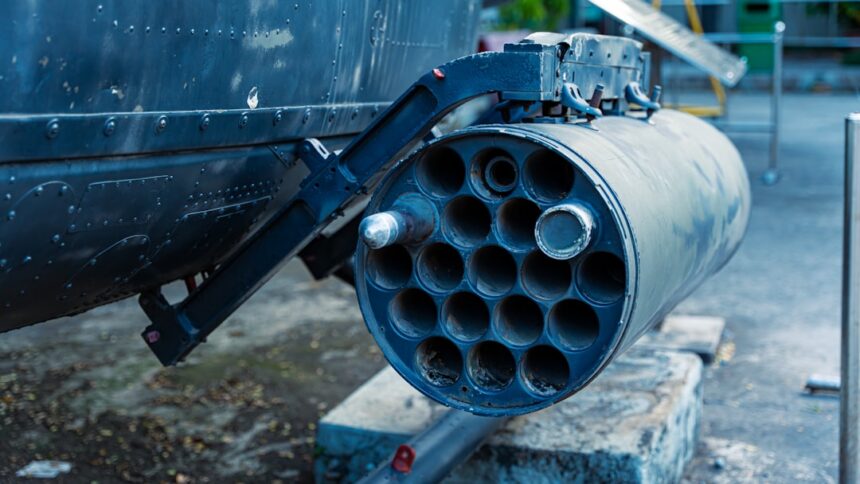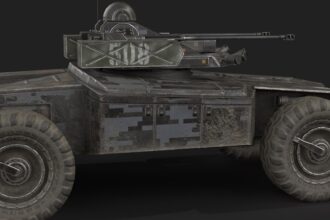The concept of rocket-propelled grenades (RPGs) can be traced back to the early 20th century, when military engineers began experimenting with various forms of portable anti-tank weaponry. The initial designs were rudimentary, often relying on simple rocket technology that had been developed for artillery and aerial applications. These early prototypes were characterized by their limited range and accuracy, but they laid the groundwork for future innovations.
As nations recognized the need for effective anti-armor solutions, the idea of a shoulder-fired weapon that could deliver explosive payloads became increasingly appealing. By the late 1930s, several countries had begun to develop more sophisticated versions of these weapons. The Soviet Union, in particular, made significant strides in this area, driven by the need to counter the growing threat of armored vehicles.
The early designs were often cumbersome and required a two-man crew for operation, but they demonstrated the potential for a lightweight, portable weapon that could be used by infantry units. This period marked the beginning of a technological evolution that would eventually lead to the modern RPGs known today.
Key Takeaways
- RPGs have a long history dating back to the early 20th century, with initial developments in rocket-propelled grenade technology occurring during World War II.
- The Cold War era saw significant advancements in RPG technology, leading to the development of more powerful and accurate RPGs.
- Modern RPGs play a crucial role in contemporary warfare, providing infantry forces with a highly effective anti-armor and anti-personnel weapon system.
- RPGs have had a significant impact on military strategy, influencing tactics and force deployment in both conventional and asymmetric warfare scenarios.
- The evolution of RPG design and functionality has led to the development of more versatile and sophisticated weapon systems, enhancing their effectiveness on the battlefield.
World War II and the Emergence of RPGs
World War II served as a catalyst for the development and deployment of rocket-propelled grenades on a larger scale. As armored vehicles became more prevalent on the battlefield, the need for effective anti-tank weapons intensified. The Soviet Union introduced the RPG-43 in 1943, which was a significant advancement over earlier designs.
This weapon featured a shaped charge that allowed it to penetrate armor more effectively, making it a formidable tool for infantry units facing German tanks. The success of the RPG-43 demonstrated the viability of rocket-propelled grenades as a critical component of ground warfare. In addition to the Soviet innovations, other nations also began to explore similar technologies.
The United States developed its own version, known as the Bazooka, which utilized a similar principle of launching a rocket-propelled explosive. These weapons were not only effective against tanks but also versatile enough to be used against fortifications and other targets. The widespread use of RPGs during World War II highlighted their importance in modern combat and set the stage for further advancements in the post-war era.
Cold War Era Advancements in RPG Technology

The Cold War period marked a significant turning point in the evolution of RPG technology. As tensions between superpowers escalated, both NATO and Warsaw Pact nations invested heavily in military research and development. The Soviet Union emerged as a leader in this field, introducing the RPG-7 in 1961, which would become one of the most iconic and widely used anti-tank weapons in history.
The RPG-7 featured a more advanced design that allowed for greater range and accuracy, as well as the ability to fire a variety of warheads tailored for different combat scenarios. During this era, RPGs became increasingly popular among various military factions around the world. Their relatively low cost and ease of use made them accessible to not only state militaries but also insurgent groups and non-state actors.
The proliferation of RPG technology during the Cold War had far-reaching implications, as these weapons became synonymous with guerrilla warfare tactics employed in conflicts across Asia, Africa, and Latin America. The adaptability of RPGs allowed them to be integrated into diverse combat strategies, further solidifying their role in modern warfare.
Modern RPGs and their Role in Contemporary Warfare
| Game Title | Release Year | Setting | Platforms | Metacritic Score |
|---|---|---|---|---|
| Call of Duty: Modern Warfare | 2019 | Contemporary | PS4, Xbox One, PC | 80 |
| Ghost Recon: Breakpoint | 2019 | Open World | PS4, Xbox One, PC | 58 |
| Battlefield V | 2018 | World War II | PS4, Xbox One, PC | 76 |
| Tom Clancy’s The Division 2 | 2019 | Post-apocalyptic | PS4, Xbox One, PC | 82 |
In contemporary warfare, rocket-propelled grenades have evolved into highly sophisticated weapons systems that play a crucial role on the battlefield. Modern RPGs are equipped with advanced targeting systems and can fire a range of munitions, including high-explosive anti-tank (HEAT) rounds, thermobaric warheads, and even guided missiles. This versatility allows military forces to engage a wide array of targets, from armored vehicles to fortified positions and personnel.
The use of RPGs has become particularly prominent in asymmetric warfare scenarios, where conventional military forces face off against irregular combatants. Insurgent groups often rely on RPGs due to their portability and effectiveness against larger military units. The ability to strike quickly and retreat before retaliation makes RPGs an invaluable asset for these fighters.
As conflicts continue to evolve, so too does the role of RPGs, adapting to meet the changing dynamics of warfare.
The Impact of RPGs on Military Strategy
The introduction and widespread use of rocket-propelled grenades have significantly influenced military strategy across various conflicts. Their effectiveness against armored vehicles has forced conventional armies to rethink their tactics and equipment. Armored units must now operate with increased caution, often relying on infantry support or air cover to mitigate the threat posed by RPGs.
This shift has led to changes in battlefield formations and strategies, emphasizing mobility and combined arms operations. Moreover, the psychological impact of RPGs cannot be understated. The mere presence of these weapons can alter the behavior of enemy forces, instilling fear and uncertainty among troops who may be vulnerable to sudden attacks from concealed positions.
This psychological dimension adds another layer to military strategy, as commanders must account for not only the physical threat posed by RPGs but also their potential to disrupt morale and cohesion within enemy ranks.
The Evolution of RPG Design and Functionality

Over the decades, the design and functionality of rocket-propelled grenades have undergone remarkable transformations. Early models were often limited by their range and accuracy, but advancements in materials science and engineering have led to significant improvements. Modern RPGs are constructed from lightweight yet durable materials that enhance portability without sacrificing performance.
Additionally, innovations in propulsion technology have increased their effective range, allowing soldiers to engage targets from greater distances. The introduction of guided RPG systems represents one of the most significant advancements in this field. These systems utilize laser guidance or other targeting technologies to improve accuracy and effectiveness against moving targets.
Such innovations have expanded the tactical applications of RPGs, enabling them to be used not only against static defenses but also against fast-moving vehicles and aircraft. As technology continues to advance, it is likely that future designs will incorporate even more sophisticated features, further enhancing their capabilities on the battlefield.
The Influence of RPGs on Insurgent and Guerrilla Warfare
Rocket-propelled grenades have had a profound impact on insurgent and guerrilla warfare tactics throughout history. Their accessibility and ease of use make them ideal for non-state actors who often operate with limited resources. Insurgent groups have effectively utilized RPGs to level the playing field against more conventional military forces, allowing them to inflict significant damage on armored vehicles and fortified positions without requiring extensive training or support.
The adaptability of RPGs has also enabled guerrilla fighters to employ hit-and-run tactics effectively. By striking quickly from concealed positions and then retreating before counterattacks can be launched, insurgents can maintain an element of surprise while minimizing their exposure to enemy fire. This strategy has been employed successfully in numerous conflicts around the world, demonstrating how RPGs have reshaped the dynamics of warfare in favor of irregular combatants.
The Proliferation of RPGs in Global Conflict Zones
The proliferation of rocket-propelled grenades has become a defining feature of modern conflict zones across the globe. As these weapons have become more widely available due to international arms trade and local production capabilities, they have found their way into various theaters of war. From urban environments to rural battlegrounds, RPGs are now commonplace among both state militaries and non-state actors alike.
This widespread availability poses significant challenges for global security efforts. The presence of RPGs in conflict zones complicates peacekeeping operations and increases the risks faced by military personnel deployed in these areas. Moreover, as these weapons continue to spread into new regions, they contribute to escalating violence and instability, making it imperative for international communities to address their proliferation through diplomatic means and arms control initiatives.
Technological Innovations in RPGs
Technological innovations have played a crucial role in shaping the capabilities of modern rocket-propelled grenades. Advances in guidance systems have led to the development of precision-guided munitions that can accurately strike targets at extended ranges. These innovations not only enhance effectiveness but also reduce collateral damage—a critical consideration in contemporary warfare where civilian populations are often caught in the crossfire.
Additionally, improvements in warhead design have resulted in more lethal options for engaging various types of targets. Modern RPGs can be equipped with specialized warheads designed for specific scenarios, such as thermobaric rounds that create devastating blast effects in enclosed spaces or tandem-charge warheads capable of defeating reactive armor on advanced tanks. As technology continues to evolve, it is likely that future innovations will further enhance the lethality and versatility of RPG systems.
The Future of RPGs in Warfare
Looking ahead, the future of rocket-propelled grenades in warfare appears poised for continued evolution. As military conflicts become increasingly complex and multifaceted, RPG technology will likely adapt to meet new challenges. Emerging trends such as urban warfare and hybrid conflict scenarios will necessitate further advancements in design and functionality.
These innovations could revolutionize how these weapons are employed on the battlefield, potentially increasing their effectiveness while minimizing risks associated with their use.
Ethical and Humanitarian Considerations in the Use of RPGs
The use of rocket-propelled grenades raises important ethical and humanitarian considerations that must be addressed by military leaders and policymakers alike. While these weapons can be effective tools for achieving military objectives, their deployment often comes with significant risks to civilian populations. In densely populated urban areas, for instance, the use of RPGs can lead to unintended casualties among non-combatants—a reality that underscores the need for strict adherence to international humanitarian law.
Furthermore, as conflicts continue to evolve and insurgent groups gain access to increasingly sophisticated weaponry like RPGs, there is an urgent need for dialogue surrounding arms control measures aimed at preventing their proliferation into unstable regions. Balancing military effectiveness with humanitarian concerns remains a critical challenge for modern militaries as they navigate complex operational environments where civilian lives are at stake. In conclusion, rocket-propelled grenades have undergone significant transformations since their inception, evolving into powerful tools that shape modern warfare dynamics.
Their impact on military strategy, insurgent tactics, and global conflict zones cannot be overstated; however, ethical considerations surrounding their use must remain at the forefront as nations grapple with the complexities inherent in contemporary armed conflict.
The evolution of rocket-propelled grenades (RPGs) has been a significant aspect of modern warfare, with advancements in technology enhancing their effectiveness and versatility on the battlefield. For a deeper understanding of how RPGs have developed over the years, you can explore a related article on this topic. This article provides insights into the historical context, technological advancements, and strategic implications of RPGs in contemporary military operations. To read more about the evolution of rocket-propelled grenades, visit the article on In The War Room.
FAQs
What is a rocket-propelled grenade (RPG)?
A rocket-propelled grenade (RPG) is a shoulder-fired anti-tank weapon that uses a rocket motor to propel an explosive warhead towards its target.
How has the RPG evolved over time?
The RPG has evolved from its early designs in the mid-20th century to more modern and advanced versions. These advancements include improvements in range, accuracy, and the ability to defeat armored vehicles.
What are some notable RPG models throughout history?
Some notable RPG models include the Soviet RPG-7, which has been widely used since the 1960s, and more modern versions such as the RPG-29 and RPG-32.
What are the key features of modern RPGs?
Modern RPGs often feature advanced sighting systems, tandem warheads for defeating reactive armor, and improved range and accuracy compared to earlier models.
How are RPGs used in modern warfare?
RPGs are commonly used by infantry forces to engage armored vehicles, fortifications, and enemy personnel. They are also used by irregular and insurgent forces in asymmetric warfare.




